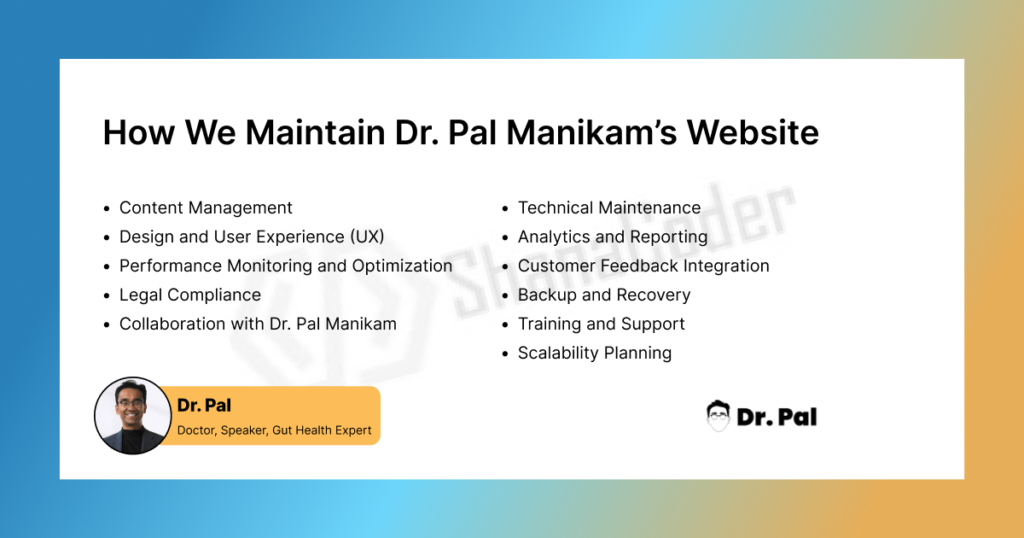Maintaining a professional website, such as Dr. Pal Manikam’s, requires a strategic approach to ensure it stays functional, visually appealing, and provides users with the information they need. Our meticulous process encompasses design updates, content optimization, advanced technical management, and client-driven revisions. Below, we’ll share the details of how we manage every aspect of the site to ensure it runs seamlessly.
1. Content Management
Regular Updates
We regularly update the website with new information, including blogs, announcements, and service updates. This ensures the content remains relevant and up-to-date.
Proofreading and Quality Control
Every piece of content is thoroughly reviewed for grammatical accuracy and clarity before it’s published.
SEO Optimization
To maintain high search engine rankings, we:
- Incorporate focus keywords naturally.
- Use meta tags and descriptions optimized for search engines.
- Regularly update existing content to reflect the latest information.
Client-Driven Changes
The client frequently shares updates, feedback, and requests via Google Docs. We:
- Implement the requested changes promptly.
- Update the Google Doc to reflect completed tasks.
- Mark updates as completed and send them for verification to ensure accuracy and satisfaction.
2. Design and User Experience (UX)
Responsive Design
We ensure the website looks great and functions perfectly on all devices, including desktops, tablets, and smartphones.
Accessibility Enhancements
Features such as alt text for images, clear navigation menus, and readable fonts make the website accessible to all users, including those with disabilities.
Visual Appeal
Periodic design tweaks, including color schemes and imagery, keep the website visually engaging and aligned with branding.
3. Performance Monitoring and Optimization
Regular Speed Tests
We conduct speed tests using tools like Google PageSpeed Insights to ensure fast loading times.
Image Optimization
All images are compressed and formatted correctly to reduce load times without compromising quality.
Caching and CDN Implementation
We use caching mechanisms and a Content Delivery Network (CDN) to improve loading speeds globally.
4. Technical Maintenance
Software Updates
We keep the website’s CMS, plugins, and themes updated to the latest versions to ensure compatibility and security.
Security Measures
Comprehensive security measures include:
- SSL certificates for encrypted connections.
- Regular malware scans.
- Firewalls to prevent unauthorized access.
Bug Fixes
A dedicated team addresses any technical issues promptly to ensure uninterrupted functionality.
5. Analytics and Reporting
Website Traffic Monitoring
We use tools like Google Analytics to track website traffic and identify trends in user behavior.
Performance Reports
Monthly reports detail the website’s performance, including visitor demographics, bounce rates, and conversion rates.
Data-Driven Improvements
Insights from analytics are used to make informed decisions about future updates and improvements.
6. Customer Feedback Integration
User Surveys
Feedback from users is collected periodically to identify areas for improvement.
Issue Resolution
Customer complaints or technical issues are resolved promptly to enhance user satisfaction.
7. Backup and Recovery
Automated Backups
Daily backups ensure the website’s data is always safe.
Disaster Recovery Plans
In case of any critical failures, our recovery plan ensures the website is restored quickly without significant downtime.
8. Legal Compliance
Privacy Policy Updates
The website’s privacy policy is regularly updated to comply with laws such as GDPR and CCPA.
Terms and Conditions Maintenance
Clear terms and conditions are maintained to outline the responsibilities of the website and its users.
9. Collaboration with Dr. Pal Manikam
Google Doc-Based Workflow
Our collaboration with Dr. Pal Manikam’s team is streamlined through the use of Google Docs. This workflow includes:
- Receiving detailed update requests and suggestions.
- Implementing changes with timestamps and progress notes.
- Marking completed tasks and sharing updates for verification.
- Maintaining a record of all changes for future reference.
Regular Communication
We maintain open lines of communication through emails and scheduled calls to address urgent needs or clarify any ambiguities in requests.
10. Training and Support
User Training
We provide training sessions for the client’s team to help them understand and use website features effectively.
Ongoing Support
Round-the-clock technical support ensures any issues are resolved promptly.
Documentation
Comprehensive documentation is provided to the client for independent management of basic functionalities if required.
11. Scalability Planning
Anticipating Growth
We design the website to accommodate future growth, whether it’s increased traffic, new features, or additional content.
Regular Evaluations
Quarterly evaluations ensure the website aligns with the client’s evolving goals and industry trends.
FAQs
1. How often is the website content updated? Content updates are performed weekly or as needed based on new information or events.
2. What tools do you use for performance monitoring? We primarily use Google Analytics and Google Page Speed Insights to monitor and optimize performance.
3. How do you ensure the website is secure? By implementing SSL certificates, regular malware scans, and advanced firewall protections.
4. What steps are taken to make the website accessible? We use accessible design principles such as alt text for images, clear navigation, and compatibility with screen readers.
5. How are client updates handled? Client updates are shared via Google Docs. We implement changes, mark them as completed, and send them for verification before finalizing.


